 When Carrie Fisher recently discovered the journals she kept during the filming of the first ‘Star Wars’ movie, she was astonished to see what they had preserved – plaintive love poems, unbridled musings with youthful naiveté, and a vulnerability that she barely recognised. Today, her fame as an author, actress and pop-culture icon is indisputable, but in 1977, Carrie Fisher was just a (sort-of) regular teenager.
When Carrie Fisher recently discovered the journals she kept during the filming of the first ‘Star Wars’ movie, she was astonished to see what they had preserved – plaintive love poems, unbridled musings with youthful naiveté, and a vulnerability that she barely recognised. Today, her fame as an author, actress and pop-culture icon is indisputable, but in 1977, Carrie Fisher was just a (sort-of) regular teenager.
With these excerpts from her handwritten notebooks, ‘The Princess Diarist’ is Fisher’s intimate and revealing recollection of what happened on one of the most famous film sets of all time – and what developed behind the scenes. And today, as she reprises her most iconic role for the latest ‘Star Wars’ trilogy, Fisher also ponders the joys and insanity of celebrity, and the absurdity of a life spawned by Hollywood royalty, only to be surpassed by her own outer-space royalty.
Laugh-out-loud hilarious and endlessly quotable, ‘The Princess Diarist’ brims with the candour and introspection of a diary while offering shrewd insight into the stardom that few will ever experience.
I was insanely excited to read ‘The Princess Diarist’ when it was first released – Princess Leia was, and still is, an amazing icon for me, and I wanted to know more about the remarkable woman who portrayed her. Then Carrie Fisher passed away, and I couldn’t bring myself to read her words. Reading something so vibrant, when Carrie was so very, very gone, was still hard all these months later. I’m glad I did though, because ‘The Princess Diarist’ is hilarious and heartfelt, and Carrie Fisher lives on in those pages.
‘The Princess Diarist’ was heavily promoted as being Carrie Fisher’s diary entries during the filming of Star Wars: a New Hope, and I was expecting a lot of the memoir to consist of the diary itself. In reality, more than half of the book consists of Carrie Fisher’s recollections and reflections, as her older self looking back on those early years. I enjoyed this immensely, as Carrie Fisher developed a hilarious writing style that makes me want to devour her other work. She was also upfront about her ongoing struggles with addiction and mental health, and how her early success in Star Wars contributed to this. This honesty and openness about topics that remain relatively taboo is so needed right now.
While I loved the reflective nature of ‘The Princess Diarist’, I really could have done without the multiple page summary of events of the 60s that served as the introduction. A brief paragraph or so would have served the same purpose, without being tedious to read. A second issue I had is that Carrie Fisher’s diary entries don’t feel completely authentic . The entries consist of prose and poetry entries that primarily detail her emotions during her affair with Harrison Ford. The entries are incredibly well written, but they also smack of being highly edited before being published. Perhaps I’m just jealous that my own diary entries consist more of cramped rants and crappy poems, as opposed to the profound emotion of Carrie Fisher’s published entries.
I really enjoyed reading Carrie Fisher’s perspective on filming Star Wars, and her humour and sass just pour off the pages of this book. I’m so glad ‘The Princess Diarist’ was published when it was, as there’s an additional and wonderful piece of Carrie Fisher that will live on in the world now.

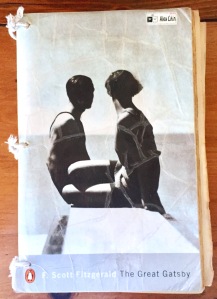 In The Great Gatsby, F. Scott Fitzgerald captures the flamboyance, the carelessness and the cruelty of the wealthy during America’s Jazz Age. The Great Gatsby lives mysteriously in a luxurious Long Island mansion, playing lavish host to hundreds of people. And yet no one seems to know him or how he became so rich. He is rumoured to be everything from a German spy to a war hero. People clamour for invitations to his wild parties. But Jay Gatsby doesn’t heed them. He cares for one person alone – Daisy Buchanan, the woman he has waited for all his life. Little does he know that his infatuation will lead to tragedy and end in murder.
In The Great Gatsby, F. Scott Fitzgerald captures the flamboyance, the carelessness and the cruelty of the wealthy during America’s Jazz Age. The Great Gatsby lives mysteriously in a luxurious Long Island mansion, playing lavish host to hundreds of people. And yet no one seems to know him or how he became so rich. He is rumoured to be everything from a German spy to a war hero. People clamour for invitations to his wild parties. But Jay Gatsby doesn’t heed them. He cares for one person alone – Daisy Buchanan, the woman he has waited for all his life. Little does he know that his infatuation will lead to tragedy and end in murder.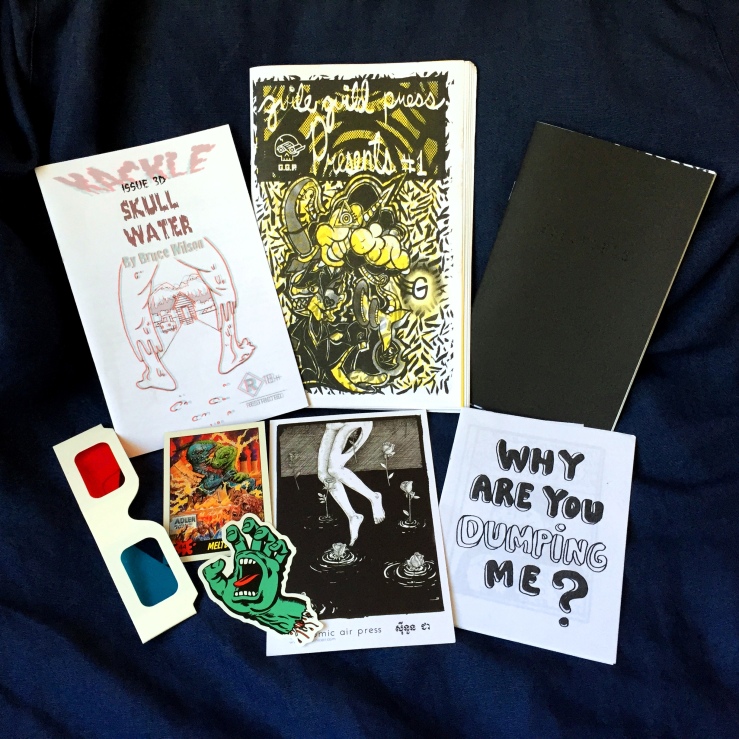
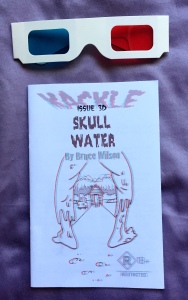 *SPOILER ALERT FOR ‘KACKLE ISSUE 3D: SKULLWATER*
*SPOILER ALERT FOR ‘KACKLE ISSUE 3D: SKULLWATER*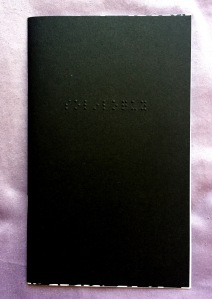 ‘Soliloquy’ is really cool. The title on the front cover is embossed in Braille, with the translation typed on the inside flap. The zine contains guides to learning and using the following forms of communication: Tap Code, Morse Code, Braille, US Sign Language, and Binary Code. It’s a really cool concept, and I’m planning to put a few days aside to at least learn Tap and Morse Codes and Braille. The tutorial on US Sign Language doesn’t help me much, as Australia has its own system (is dialect an appropriate word in this context?). This has definitely inspired me to seek out some lessons in Australian Sign Language on the internet. Soliloquy was clearly a well thought out and executed zine that provides information about the various forms of communication that it then teaches. I’m really pleased with this one.
‘Soliloquy’ is really cool. The title on the front cover is embossed in Braille, with the translation typed on the inside flap. The zine contains guides to learning and using the following forms of communication: Tap Code, Morse Code, Braille, US Sign Language, and Binary Code. It’s a really cool concept, and I’m planning to put a few days aside to at least learn Tap and Morse Codes and Braille. The tutorial on US Sign Language doesn’t help me much, as Australia has its own system (is dialect an appropriate word in this context?). This has definitely inspired me to seek out some lessons in Australian Sign Language on the internet. Soliloquy was clearly a well thought out and executed zine that provides information about the various forms of communication that it then teaches. I’m really pleased with this one.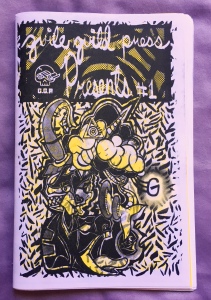 ‘Guile Guild Press #1’ is yet another art book, made up of various contributions instead of one or two artists’ work. There’s plenty of variety, but the quality between contributions varied widely. One particular comic ‘Proletarian Comix’ was drawn very heavily with limited space, and as such it was hard to read the captions or even differentiate arms from legs. A lot of the art has underlying political or social commentary, which is cool for a while but does tend to drag your mood down when every art work tells you that we’re selfish and doomed. You definitely have to be in the right frame of mind to peruse it, or you’ll just end up angry and more depressed than when you first opened the covers.
‘Guile Guild Press #1’ is yet another art book, made up of various contributions instead of one or two artists’ work. There’s plenty of variety, but the quality between contributions varied widely. One particular comic ‘Proletarian Comix’ was drawn very heavily with limited space, and as such it was hard to read the captions or even differentiate arms from legs. A lot of the art has underlying political or social commentary, which is cool for a while but does tend to drag your mood down when every art work tells you that we’re selfish and doomed. You definitely have to be in the right frame of mind to peruse it, or you’ll just end up angry and more depressed than when you first opened the covers.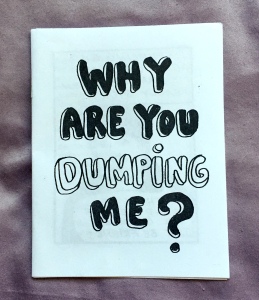 ‘Why are you dumping me?’ was good for a quick laugh, but it’s funnier when you can’t relate at all. Sandra’s real-life dumping scenarios will hit too close to home when you have a few tragic stories of your own to bring to the table. I reread this following an awkward attempt at wooing and I found that it wasn’t nearly as funny as when I was innocent and free. Or maybe the wound is still too raw. Either way, Sandra has a real skill with drawing expressions in simple cartoons, and the accompanying illustrations made the captions even funnier. She has a zine available on her Etsy store ‘BogusPress’, and I just might make the purchase and see if the rest of her work is as good.
‘Why are you dumping me?’ was good for a quick laugh, but it’s funnier when you can’t relate at all. Sandra’s real-life dumping scenarios will hit too close to home when you have a few tragic stories of your own to bring to the table. I reread this following an awkward attempt at wooing and I found that it wasn’t nearly as funny as when I was innocent and free. Or maybe the wound is still too raw. Either way, Sandra has a real skill with drawing expressions in simple cartoons, and the accompanying illustrations made the captions even funnier. She has a zine available on her Etsy store ‘BogusPress’, and I just might make the purchase and see if the rest of her work is as good.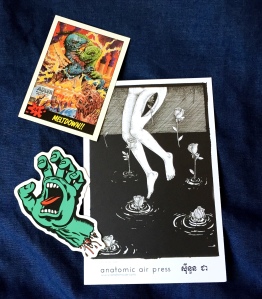 Out of all the extras, my favourite is a post card with art by Joe Elias Tsambiras. It’s so pretty, and I love the contrasting shades and textures. Is it weird to frame it – because I want to. There was a sticker of a dismembered arm with a mouth that reminds me of a band shirt from the 80s, and a card illustration of two giant lizards fighting. I do not know what to do with that. I sense a spontaneous gift to a stranger on a train in my future.
Out of all the extras, my favourite is a post card with art by Joe Elias Tsambiras. It’s so pretty, and I love the contrasting shades and textures. Is it weird to frame it – because I want to. There was a sticker of a dismembered arm with a mouth that reminds me of a band shirt from the 80s, and a card illustration of two giant lizards fighting. I do not know what to do with that. I sense a spontaneous gift to a stranger on a train in my future.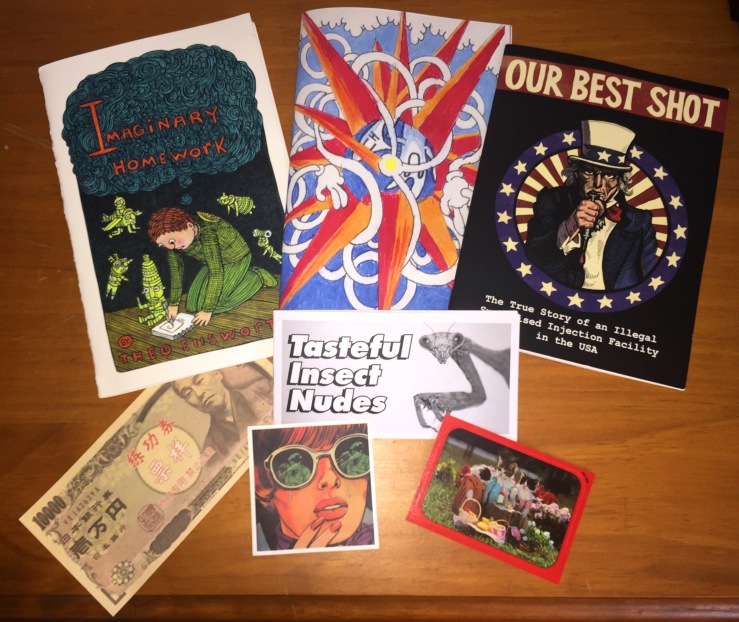
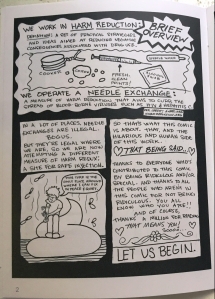
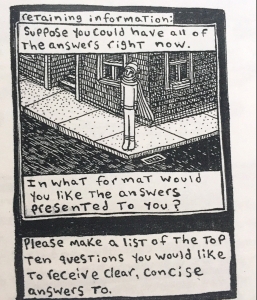
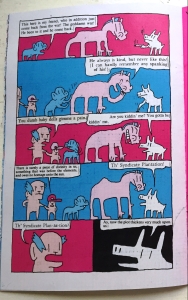
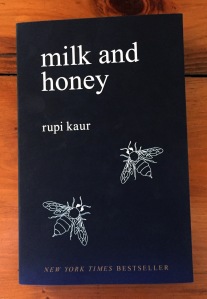 this is the journey of
this is the journey of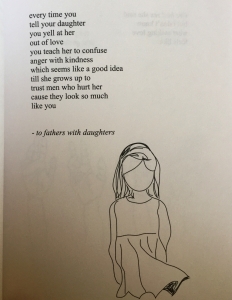 While a large number of the poetry in ‘milk and honey’ is love poetry, it’s love in all forms. Mutual love, sexual love, and dysfunctional love are all represented, as is a growing sense of physical and mental empowerment. The women conjured by these poems are not meek and waiting, but strong beings who’d rather do without than suffer a self-destructive relationship. Kaur beautifully conveys both the pain of leaving and the joy of escaping a love turned sour. The poetry is also accompanied by simple yet striking illustrations, which enhance the imagery of the language without distracting from the content. They are a beautiful embellishment, and make me want to frame my favourite poems and put them on my walls.
While a large number of the poetry in ‘milk and honey’ is love poetry, it’s love in all forms. Mutual love, sexual love, and dysfunctional love are all represented, as is a growing sense of physical and mental empowerment. The women conjured by these poems are not meek and waiting, but strong beings who’d rather do without than suffer a self-destructive relationship. Kaur beautifully conveys both the pain of leaving and the joy of escaping a love turned sour. The poetry is also accompanied by simple yet striking illustrations, which enhance the imagery of the language without distracting from the content. They are a beautiful embellishment, and make me want to frame my favourite poems and put them on my walls.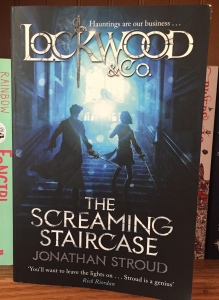 When the dead come back t haunt the living, Lockwood & Co. step in…
When the dead come back t haunt the living, Lockwood & Co. step in…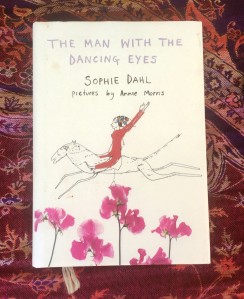 ‘In the golden half-light of a midsummer’s evening, the sort where any kind of magic can occur, and often does, in the midst of a party held in a wild and rambling garden, stood Pierre, teetering on highly unsuitable heels, surrounded by a symphony of overripe roses.’
‘In the golden half-light of a midsummer’s evening, the sort where any kind of magic can occur, and often does, in the midst of a party held in a wild and rambling garden, stood Pierre, teetering on highly unsuitable heels, surrounded by a symphony of overripe roses.’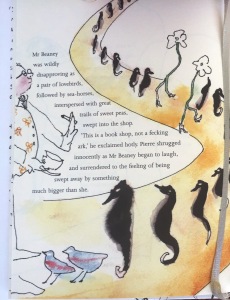
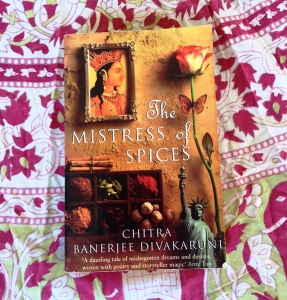 Tilo, an immigrant from India, runs a spice shop in Oakland, California. While she supplies the ingredients for curries and kormas, she also helps her customers to gain a more precious commodity: whatever they most desire. For Tilo is a Mistress of Spices, a priestess of the most magical powers of spices.
Tilo, an immigrant from India, runs a spice shop in Oakland, California. While she supplies the ingredients for curries and kormas, she also helps her customers to gain a more precious commodity: whatever they most desire. For Tilo is a Mistress of Spices, a priestess of the most magical powers of spices.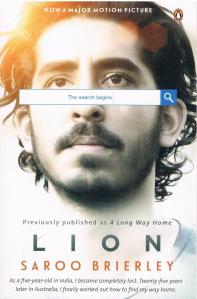 When Saroo Brierley used Google Earth to find his long-lost home town half a world away, he made global headlines.
When Saroo Brierley used Google Earth to find his long-lost home town half a world away, he made global headlines.